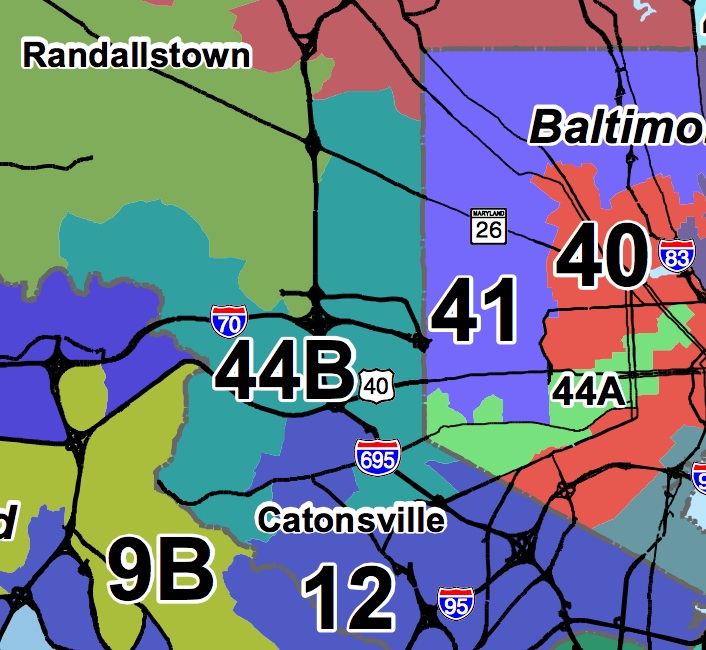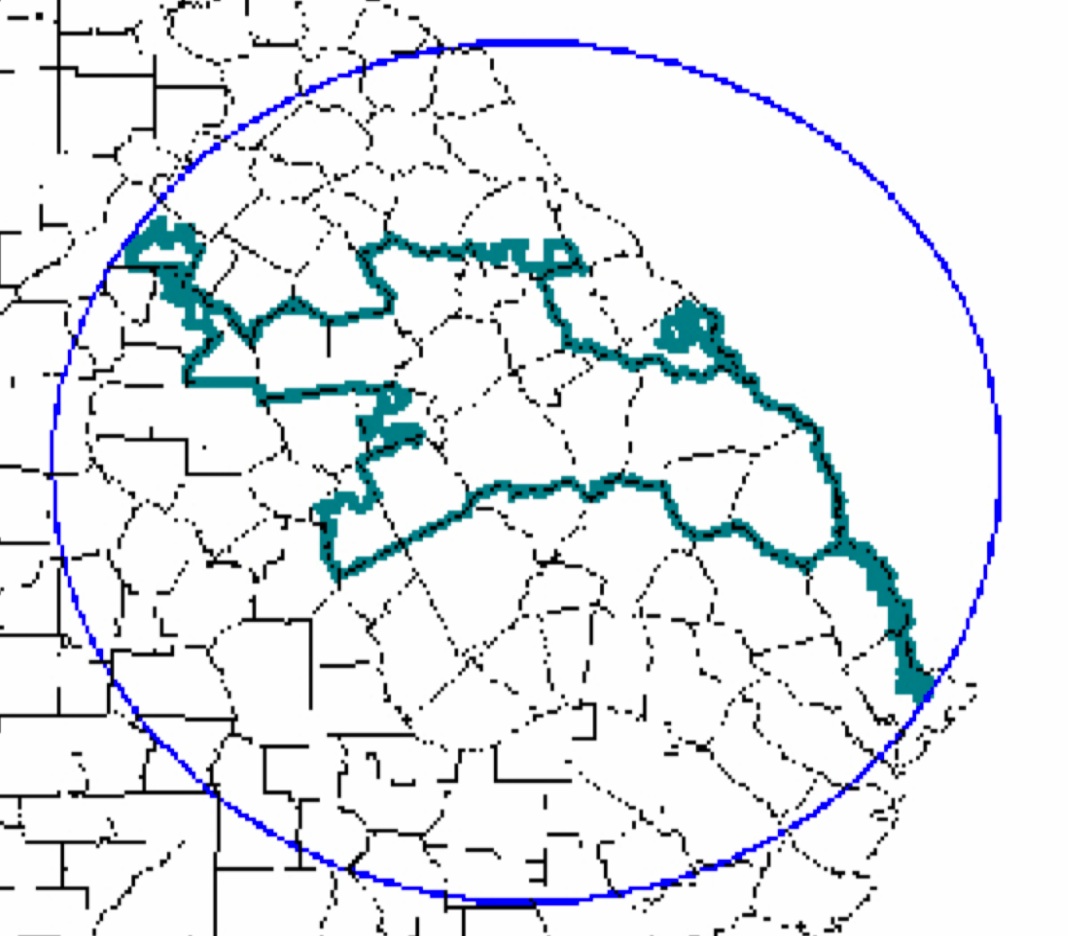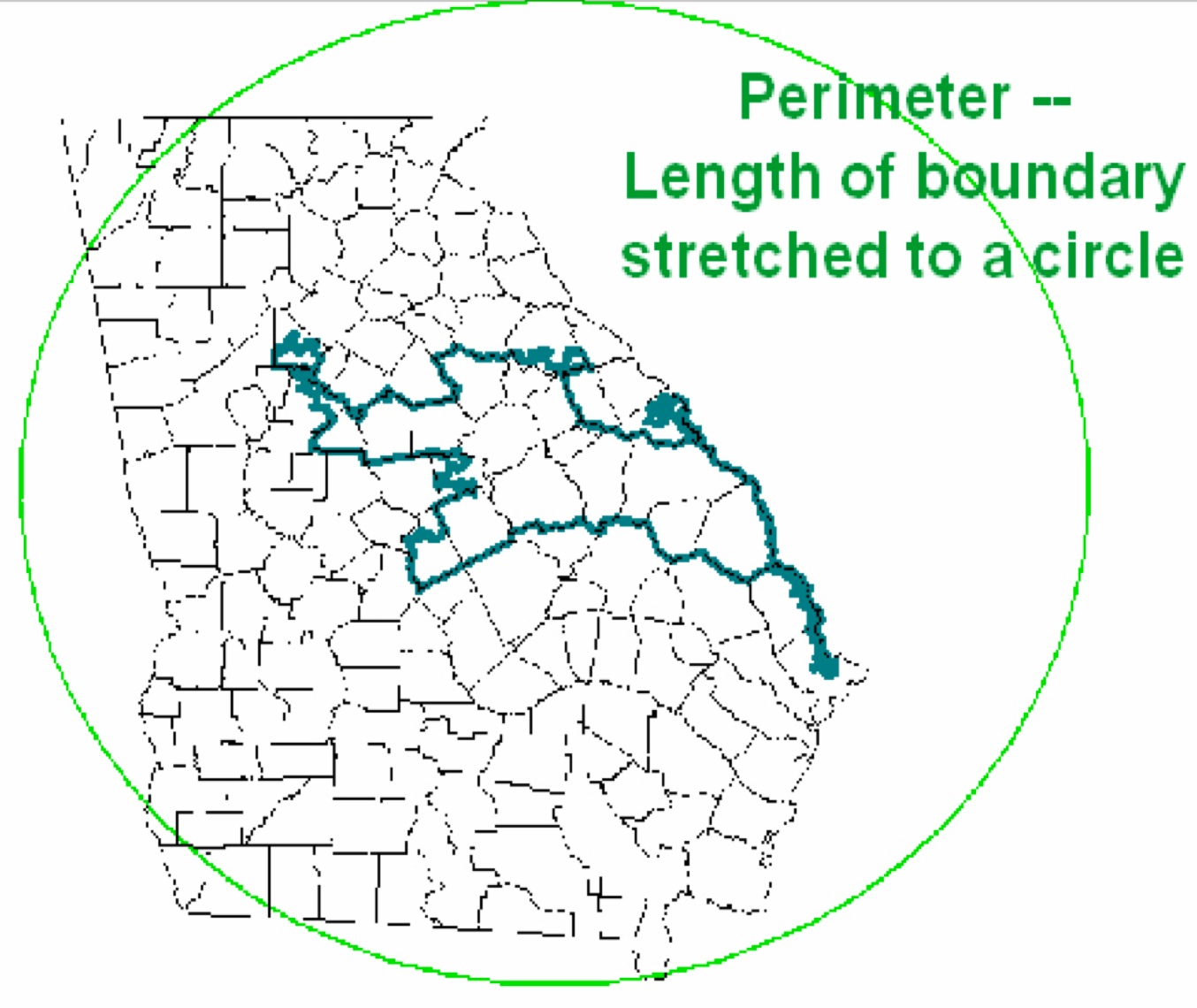Montgomery County Council Candidate Evan Glass kicked off his campaign at El Golfo restaurant:
Monthly Archives: March 2014
Purple Line ROD Signed
From Purple Line Now:
The MTA just announced that the Record of Decision for the Purple Line has been signed. Formal announcement to follow next week.
As the Maryland Transit Administration’s (MTA) website explains, the Record of Decision is:
The final approval of an Environmental Impact Statement which will be issued by Federal Transit Administration. It is a public document that explains the reasons for a project decision and summarizes any mitigation measures that will be incorporated in the project. Obtaining the ROD is the last step in the NEPA process. After a ROD is received, permits and right-of-way can be acquired.
Green Endorsements
The League of Conservation Voters and Sierra Club have endorsed a slew of General Assembly candidates. Here is a combined list of the two with non-incumbents in boldface. (L) indicates endorsed just by the League and (S) indicates endorsed just by the Sierra Club.
All of the endorsed non-incumbents for the Senate are currently delegates, though Veronica Turner is the only challenger endorsed over an incumbent for the Senate.
A total of non-incumbents have been endorsed for delegate by either organization–all for open seats. The League endorsed Rick Kessler, as well as the three incumbents in District 18. The LCV also endorsed four including two challengers–David Moon and Darien Unger in District 20..
By far the most endorsements were made in Montgomery County, an indication of the importance of environmental issues to many voters in the County. Prince George’s came up second.
District 3 (Frederick and Washington)
Senate: Ron Young (L)
District 6 (Baltimore County)
Senate: Johnny Olszewski, Jr. (L)
District 10 (Baltimore County)
Senate: Delores Kelly (L)
House: Adrienne Jones (L)
District 11 (Baltimore County)
Senate: Bobby Zirkin (L)
House: Dan Morhaim, Dana Stein
District 13 (Howard)
Senate: Guy Guzzone (L)
House: Shane Pendergrass, Frank Turner
District 14 (Montgomery)
Senate: Karen Montgomery
House: Anne Kaiser, Eric Luedtke, Craig Zucker
District 15 (Montgomery)
Senate: Brian Feldman
House: Aruna Miller, Kathleen Dumais
District 16 (Montgomery)
Senate: Susan Lee
House: Ariana Kelly, Hrant Jamgochian (S), Marc Korman (S)
District 17 (Montgomery)
House: Kumar Barve, Jim Gilchrist, Andrew Platt (S)
District 18 (Montgomery)
Senate: Rich Madaleno
House: Al Carr, Ana Sol Gutiérrez, Jeff Waldstreicher, Rick Kessler (L)
District 19 (Montgomery)
Senate: Roger Manno
House: Bonnie Cullison, Ben Kramer, Charlotte Crutchfield (S)
District 20 (Montgomery)
Senate: Jamie Raskin
House: Sheila Hixson, Will Smith, David Moon (L), Darien Unger
District 21 (Anne Arundel and Prince George’s)
Senate: Jim Rosapepe
House: Ben Barnes, Barbara Frush, Joseline Peña-Melnyk
District 22 (Prince George’s)
Senate: Paul Pinsky
House: Anne Healey (L), Tawanna Gaines (L)
District 23 (Prince George’s)
Senate: Doug Peters (L)
House A: Jim Hubbard (S)
House B: Marvin Holmes (L)
District 24 (Prince George’s)
Senate: Joanne Benson (L)
House: Carolyn Howard (L)
District 25 (Prince George’s)
House: Dereck Davis (L)
District 26 (Prince George’s)
Senate: Veronica Turner (L)
House: Kris Valderrama, Jay Walker (L)
District 27 (Calvert and Prince George’s)
House A: James Proctor, Jr. (L)
House C: Sue Kullen
District 28 (Charles)
House: Peter Murphy (L), C.T. Wilson (L)
District 30 (Anne Arundel)
House: Michael Busch
District 32 (Anne Arundel)
House: Pam Beidle
District 39 (Montgomery)
Senate: Nancy King
House: Charles Barkley, Kirill Reznick, Shane Robinson
District 40 (Baltimore City)
House: Barbara Robinson (L), Shawn Tarrant (L)
District 41 (Baltimore City)
House: Jill Carter (L), Sandy Rosenberg (L)
District 42 (Baltimore County)
Senate: Jim Brochin
House A: Stephen Lafferty
District 43 (Baltimore City)
House: Curt Anderson (L), Maggie McIntosh, Mary Washington
District 44 (Baltimore City and County)
House A: Kieffer Mitchell (L)
District 45 (Baltimore City)
House; Talmadge Branch (L), Cheryl Glenn (L)
District 46 (Baltimore City)
Senate: Bill Ferguson
House: Luke Clippinger (L), Peter Hammen (L), Brooke Lierman (L)
District 47 (Prince George’s)
Senate: Victor Ramirez (L)
House A: Michael Summers
Three Delegates, One Seat
A previous post examined the Senate race in drastically reconfigured District 44–the only one in which the challenger is favored over the incumbent–so I thought I’d look at the competitive delegate race in District 44A.
District 44 drew the short end of the stick in Baltimore City’s redistricting game of musical chairs with most of the district moved out of the City into the County. As a result, three incumbents are now competing for the sole delegate seat in District 44A, the portion left in the City.
District 44A has three incumbents vying for one seat: Dels. Keith Haynes, Kieffer Mitchell, and Melvin Stukes.
Del. Keiffer Mitchell, heir to the Mitchell political dynasty, is a nice guy who came very close to first-place finisher Haynes in his first delegate campaign in 2010. Del. Keith Haynes is running for his fourth term, where he sits on the Appropriations Committee, but has not been a stand out.
Del. Melvin Stukes came in third but well behind Mitchell and Haynes. The City Paper criticized Stukes for his fecklessness as long ago as 1999 when he served on the City Council:
In two terms on the council Stukes has made his mark as an anti- environmentalist, an unflinching rubber stamp for the mayor’s pet projects, and an incurable windbag, but he’s utterly failed to distinguish himself as a representative of the people.
Stukes also attracted deserved negative attention during the fierce debate over marriage equality. After sponsoring the bill for several years, he claimed he thought it allowed civil unions rather than marriage even though the word “marriage” appears in the title. Much was also made of the heat Stukes took from his barber:
In West Baltimore, Lenny Clay, the politically powerful owner of the West Baltimore barbershop Lenny’s House of Naturals, gave Del. Melvin Stukes an earful for sponsoring the same-sex marriage bill in the House.
He recalled telling Stukes: “You should burn your Bible, because you are no longer following your book.”
Instead Stukes took his name off the bill and will not support it.
When the going gets tough, Stukes goes away.
I’m sure Mitchell faced similar criticism from some friends but he seemed very much at peace with his decision and happy to take a leadership role in pushing for the bill in the House. In Stukes’ case, we can either believe he is that stupid or unreliable. Based on his public comments, he wants us to go with stupid.
Regardless, it seems likely that Stukes will be out of the House after the primary. He fared poorly four years ago compared to Haynes and Mitchell. Moreover, he had just $10K cash in his campaign kitty compared to $32K for Haynes and $24K for Mitchell. None can raise more money until the session ends.
It should be a tough race between Haynes and Mitchell. Haynes has four terms under his belt so he has name recognition in the district as well as the cash advantage. Mitchell already showed he is a fierce campaigner in his first outing four years ago.
Turner-Valderrama-Sloan Form D26 Unity Slate
 Del. Kris Valderrama, Candidate David Sloan and Del. Veronica Turner
Del. Kris Valderrama, Candidate David Sloan and Del. Veronica Turner
Del. Veronica Turner’s bid to unseat incumbent Sen. Anthony Muse just got a major shot in the arm. Together with Del. Kris Valderrama and David Sloan, Turner has formed the District 26 Unity Slate.
As I explained in my profile of the D26 Senate race, the alliance with Sloan had been rumored for awhile. Valderrama’s participation also does not shock. In 2010, Muse did not endorse Valderrama and then accused her of disseminating misleading information about him.
Like Turner, Valderrama is perceived as more progressive than Muse. Both Turner and Valderrama backed marriage equality despite Muse’s fierce opposition and criticism. Del. Jay Walker joined Muse in speaking at a tea-party organized rally against it.
Walker is supporting Tony Knotts for delegate so this seems a tacit rival to the formally announced D26 Unity Slate, as only three people can win election as delegate. I don’t know if Walker or Knotts are running with Muse. Though this would seemingly be the logical next step, the presence of five other candidates besides Valderrama and Sloan may complicate matters.
The District 26 Unity Slate held their first event on Monday at Mrs. Philippines Home and will hold their office opening on April 12th. The ticket works to the advantage of all the candidates as they benefit from mutual support and can multiply the impact of money and canvassing by working together. Of course, they also lend each other credibility in their campaigns.
Rorschach Map of Incumbent Desires
Much has been made of the, ahem, “creative” boundaries of Maryland’s current congressional districts. A previous post provided more detailed maps that show the true artistry of the districts. But here is a statewide view that probably doesn’t do it full justice:
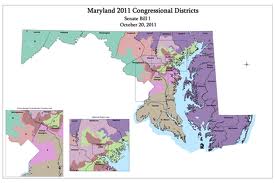 Maryland’s Current Congressional District Map
Maryland’s Current Congressional District Map
Many cite the non-compact boundaries as evidence of partisanship. Certainly, the 6th District was reconfigured to aid Democrats, who picked up the seat in 2012. However, Democrats did not have to draw these non-compact districts to gain a 7-1 majority in place of the previous 6-2 split. The following plan has seven districts that Obama won by 15% or more in 2008:
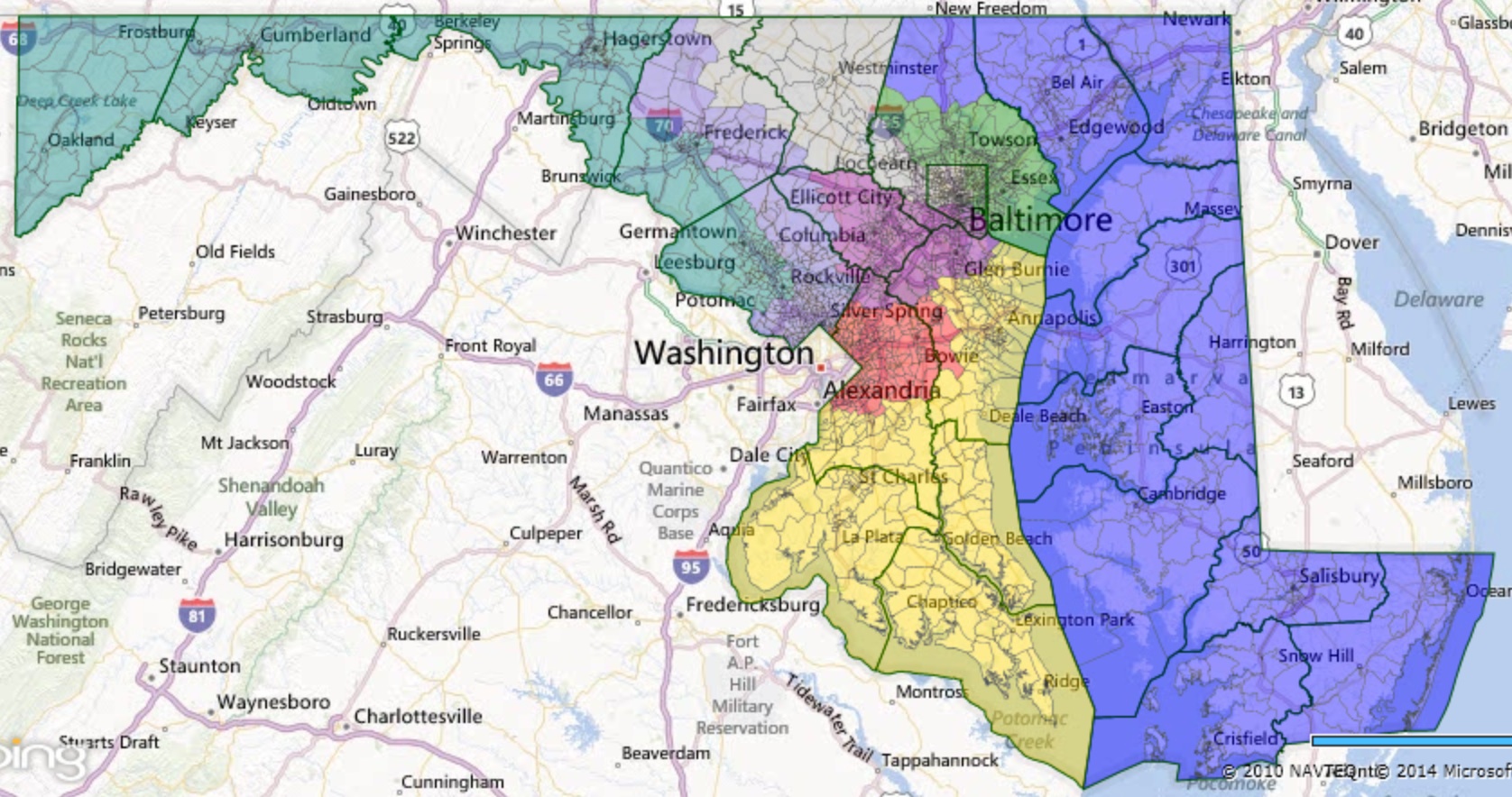 Alternative Congressional Plan 1
Alternative Congressional Plan 1
While probably not the most compact plan that could be drawn, it also is clearly much more compact than the enacted plan. Beyond containing seven very Democratic districts, it also still contains two districts that are over 50% black in voting-age population.
A map that gave Democrats at least a 10% advantage in seven districts, again as measured by support for Obama in 2008, could be made even more compact and violate fewer county boundaries:
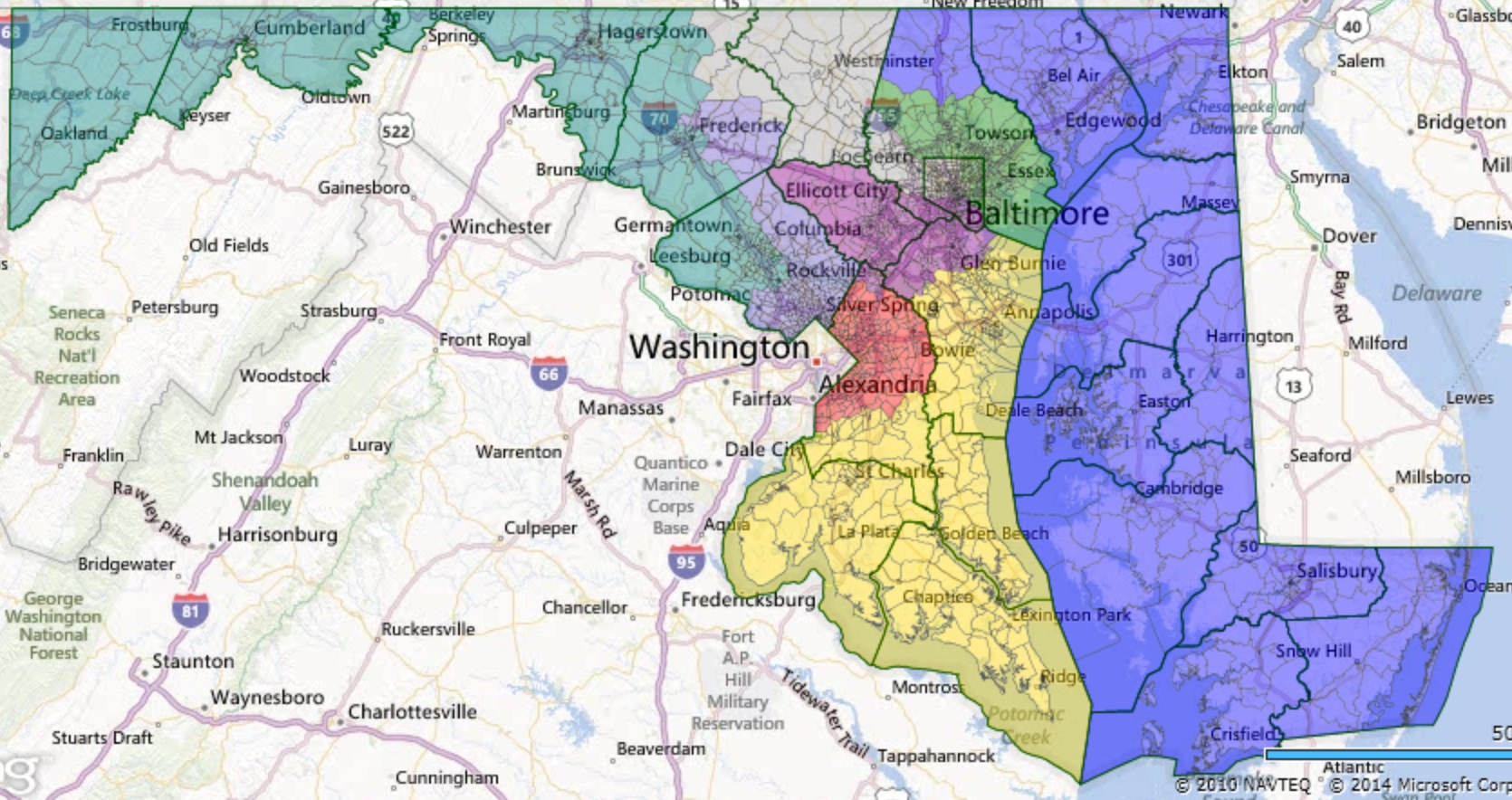 Alternative Congressional District Plan 2
Alternative Congressional District Plan 2
In this version, District 8 doesn’t reach the Pennsylvania border or take in any portion of Carroll County, which is no longer split. The Fourth District is also entirely within Prince George’s. Montgomery County has only two districts instead of three.
So why did the Democrats choose to adopt a plan with such meandering districts instead of a simpler version? According to many different sources, the answer lies in the desire to favor the preferences of certain incumbents, even when they were highly idiosyncratic and would not alter their reelection chances.
(1) Rep. Steny Hoyer insisted on continuing to represent UMD College Park, which he has represented since entering Congress. (Love the Turtle!) However, College Park is at the northwestern end of Prince George’s. Accommodating the desires of this powerful representative forced many other changes to plan.
For example, the 4th couldn’t continue to go into Montgomery if the 6th was to take in significant portions of that County, so the 4th now crawls around the edge of Prince George’s to enable it to scoop up Republican voters in Anne Arundel.
(2) Similarly, Rep. Dutch Ruppersberger sits on the intelligence committee and wanted to represent both Fort Meade and the Aberdeen Proving Ground. (Couldn’t we just buy him his own spy cam?) Even more creativity ensued as these two facilities lies at the opposite ends of the Baltimore region
(3) Rep. Elijah Cummings did not want to represent Carroll County, throwing yet another complication into the mix. Carroll is very Republican but would have easily been swamped by Cummings’ Baltimore base. So now Rep. Chris Van Hollen represents parts of Carroll County.
(4) Rep. John Sarbanes felt strongly that he wanted to continue to represent Annapolis, adding another layer of complexity into the plan’s requirements. Drafting a plan to satisfied this demand along with Ruppersberger’s helps explain how the 2nd and 3rd districts took on even more convoluted shapes.
(5) Complicating it all further was that so several representatives–Cummings, Harris, Ruppersberger, and Sarbanes–live with a small area near Baltimore. While living in the district is not required–just ask John Delaney–most prefer to do it.
And that’s how we ended up with this:
By the way, there is no legal impediment to gerrymandering for incumbents. Indeed, courts have cited it as a legitimate rationale for states to craft plans in a particular manner.
MCEA Endorsements
The influential Montgomery County Educational Association has issued new endorsements for state legislative elections. So far, these choices are very conservative bets. They have endorsed all but one incumbent running for reelection.
In District 16, Susan Lee is also a lock for the Senate. All of the endorsed non-incumbent delegates are seen as having good chances, though the races in District 16 and 20 are the most up for grabs with other candidates having strong shots.
The only outstanding endorsement is in District 15 where recently appointed incumbent David Fraser-Hidalgo has not been endorsed. Rumor has it that they had planned to endorse challenger Bennett Rushkoff but that he did not receive the required super majority. We’ll see if MCEA picks Fraser-Hidalgo, Rushkoff, or no one.
Here is the current list with non-incumbents in boldface:
District 14
Senate: Karen Montgomery
Delegate: Anne Kaiser, Eric Luedtke and Craig Zucker
District 15
Senate: Brian Feldman
Delegate: Kathleen Dumais and Aruna Miller (one still pending)
District 16
Senate: Susan Lee
Delegate: Bill Frick, Ariana Kelly and Hrant Jamgochian
District 17
Senate: No Endorsement
Delegate: Kumar Barve, Jim Gilchrist and Andrew Platt
District 18
Senate: Rich Madaleno
Delegate: Al Carr, Ana Sol Gutiérrez and Jeff Waldstricher
District 19
Senate: Roger Manno
Delegate: Bonnie Cullison and Ben Kramer (no third endorsement)
District 20
Senate: Jamie Raskin
Delegate: Sheila Hixson, David Moon and Will Smith
District 39
Senate: Nancy King
Delegate: Charles Barkley, Kirill Reznick and Shane Robinson
Thanks @MoCoYoungDems
I just wanted to thank the Montgomery County Young Democrats for having me over tonight. I had a blast meeting lots of people and sizing up the races. Oddly enough, I even got to feel young as the MCYDs are older than the students I taught earlier in the day.
Paraphrases of a few of the really good questions they asked: Will the state legislative delegation and county council get along better after the elections? Why isn’t there more competition in the County Council races? Which incumbent is most likely to lose the at-large races? Will the General Assembly take up legislation on GMOs soon? Will our delegation be more progressive after the election? How can our elected officials be more effective in Annapolis?
Kudos to Melissa Pinnick for taking the lead in organizing a MCYD team for the American Cancer Society Relay for Life in Rockville. Click to sign up for this event or make a donation in support of this event.
I’d say it was great to meet future leaders but this is an active and influential group. Almost all of them are already highly active in leadership roles around the County and the State.
They’re also smart. They found the secret entrance on Platform 2 1/2 of the Bethesda Metro Station to the B-CC Regional Services Center. Marc Korman and Jordan Cooper promised that, if elected, they’ll make it easier to find.
All the Pretty Districts
In two posts yesterday, I argued that Maryland’s congressional redistricting plan is less outrageously biased to the Democrats than assumed by many despite its extremely non-compact lines. This post focuses on why pretty, compact lines may not produce plans that treat both parties fairly.
First, one can still gerrymander without necessarily producing especially non-compact shapes. In the 1980s, Arizona GOP adopted a plan that did not look particularly bad but still worked greatly to their benefit by packing Democrats into a single district.
The one Democratic district had a reasonably regular triangular shape. But it stretched across hundreds of miles of empty desert with its vertices being Yuma along with the especially Democratic sections of Phoenix and Tucson.
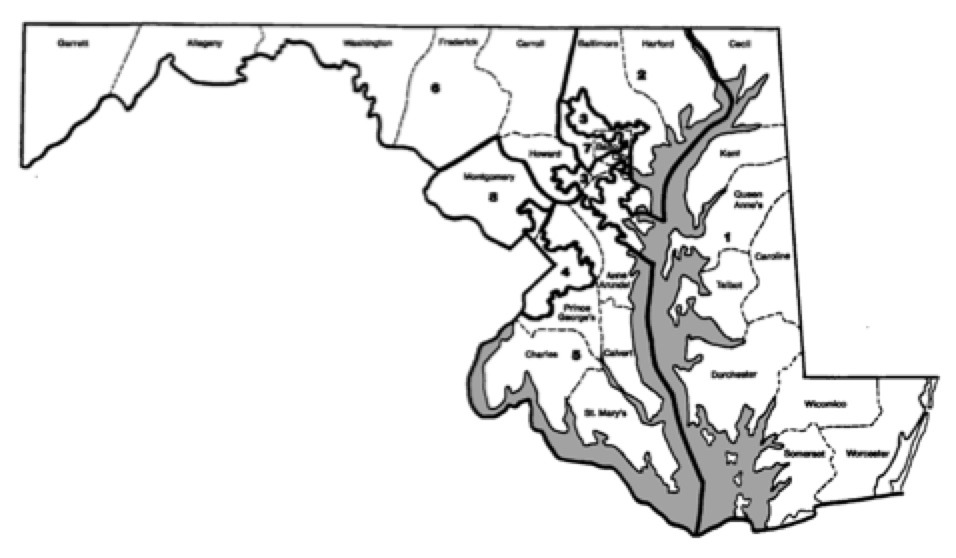 Maryland Congressional Plan 1992-2000
Maryland Congressional Plan 1992-2000
The Maryland plan used from 1992 through 2000 may not have been as compact as possible but was much more so than the current plan. Though drafted by Democrats, it didn’t work very well for them in the 2000 elections.
 2000 Maryland Congressional Results
2000 Maryland Congressional Results
The Democrats won by more than 200,000 votes, or 11%, but still only won 50% of the eight seats. Usually, though by no means always, a clear win in votes will give the majority party more than its fair share of seats.
As this example demonstrates, the outcome in single-member district electoral systems depends heavily upon how the votes are distributed. Parties lose out when they supporters are not efficiently spread across the state.
Parties whose voters are too packed–that is, over concentrated–into a few districts will win those districts by wide margins but forgo opportunities to gain neighboring districts. On the other hand, parties with supporters spread too thinly risk winning no seats even if they receive many votes. In winner-take-all elections, there is no prize for second place.
The distribution of voters often has a major impact on election outcomes even if constituency boundaries are drawn by excellent nonpartisan procedures. The United Kingdom has nonpartisan boundary commissions draw their maps. Yet they hardly treat the two largest parties equally.
Between 1979 and 1992, the Conservatives won four straight elections with between 42% and 44% of the vote. Their majorities varying greatly in size, ranging from 52% to 61% of parliamentary seats. They performed at their best in 1983 when the second and third place parties nearly tied, leaving the Conservatives ahead in more seats than other years.
Labour won 41% to 43% of the vote in 1997 and 2001 but gained more substantial majorities–62% to 63% of all seats–than the Conservatives did with about the same vote share. In 2005, Labour even gained a majority of 55% of seats with just 35% of the vote, the lowest share in British history. However, the Conservatives gained only a minority in 2010 with 36% of the vote.
The key lesson is that maps with compact districts and regular lines do not necessarily produce unbiased outcomes that reward parties with an equal number of seats for the same share of votes. The distribution of voters is critical.
Next up: competitiveness, responsiveness and redistricting.
Compactness in Redistricting
When people refer to geographical compactness, they refer to districts of sensible shape. Why does this matter? First, odd shapes can indicate gerrymandering. Second, the idea of single-member districts is grounded in the representation of territorially organized communities where each area has its representative, though many dispute this idea of community.
One common compactness measure, usually referenced as the Reock or Dispersion measure, is the ratio of the area of a district to the area of the smallest circle that can enclose the district:
Reock or Dispersion Measure of Compactness
The idea behind the measure is that a circle is the most compact shape, so it compares the district to the smallest circle that can encompass it. As the name indicates, it is viewed as a good measure of the dispersion of the area of a district.
Another widely used compactness measure is the ratio of the area of a district to the area of a circle with the same perimeter as the district (the Polsby-Popper or Perimeter measure):
Polsby-Popper or Perimeter Measure
This measure tends to give low (i.e. worse) scores to districts with many crinkles in their boundaries and that are elongated in ways that stretch their boundaries but encompass little territory. In contrast, districts with smooth boundaries that maximize the area enclosed score well.
Complaints about both measures include that one cannot draw only circular districts and that state boundaries are not circular. For this reason, it is important to compare district scores to other districts and especially other plans for districts in the same state.
A final compactness measure is the Grofman Interocular Test. Developed by my humorous friend and sometime coauthor, Bernie Grofman, it’s his way of asking does “evidence of gerrymandering leap up and hit you in the eyeballs.” Rather like Justice Stewart said about pornography, gerrymandeirng can be hard to define but you know it when you see it.
Closely related to compactness are the ideas of contiguity and adherence to administrative boundaries. Contiguity is simply that one could, at least in theory, travel from any point in a district to any other point without leaving the district. A stricter version might require that one can travel in practice without having to cross into another district.
Federal law now requires that congressional districts be contiguous in the looser sense. In recent times, some districts have stretched the principle thinly with point contiguity, which is when districts remain connected at just one point.
Others value adherence to administrative boundaries, such as county and municipal lines, as helping preserve natural communities of interest. Of course, like districts, the boundaries of these units are drawn by people and not truly natural.
Maryland’s districts unquestionably fail any test for compactness. I’m including maps here of four of the eight districts to do the artistry of the plan full justice:
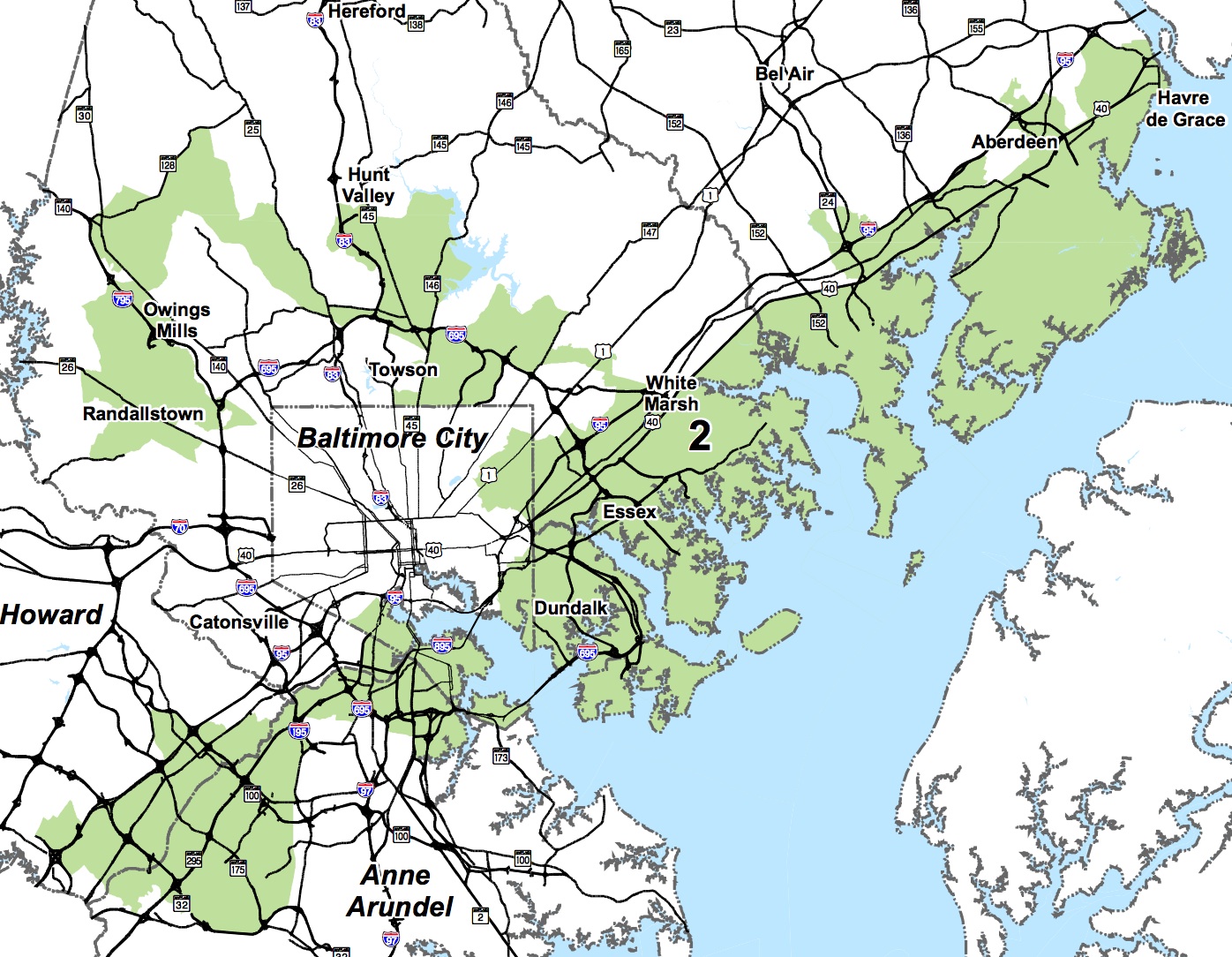 Maryland’s Second Congressional District
Maryland’s Second Congressional District
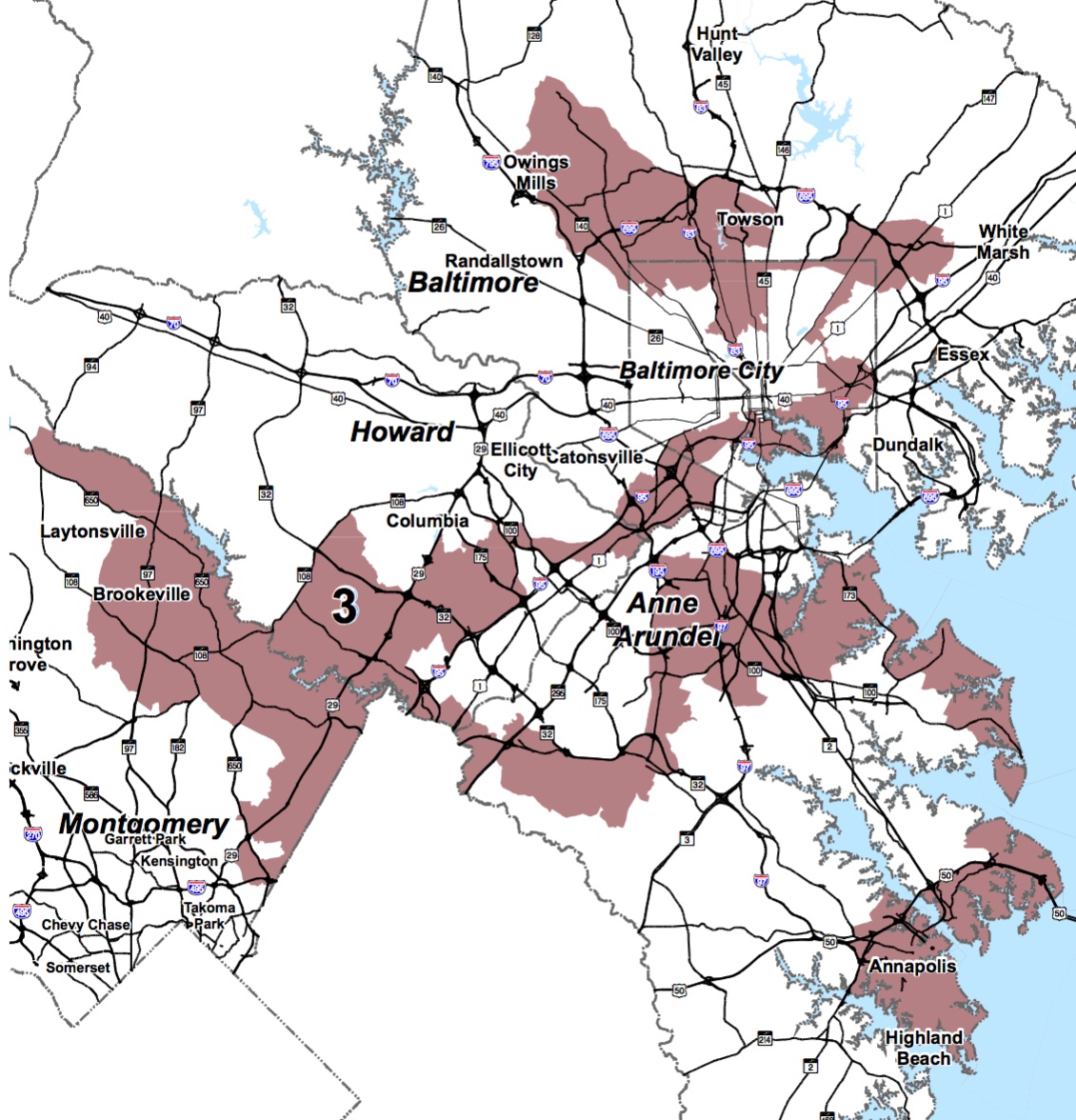 Maryland’s Third Congressional District
Maryland’s Third Congressional District
 Maryland’s Fourth Congressional District
Maryland’s Fourth Congressional District
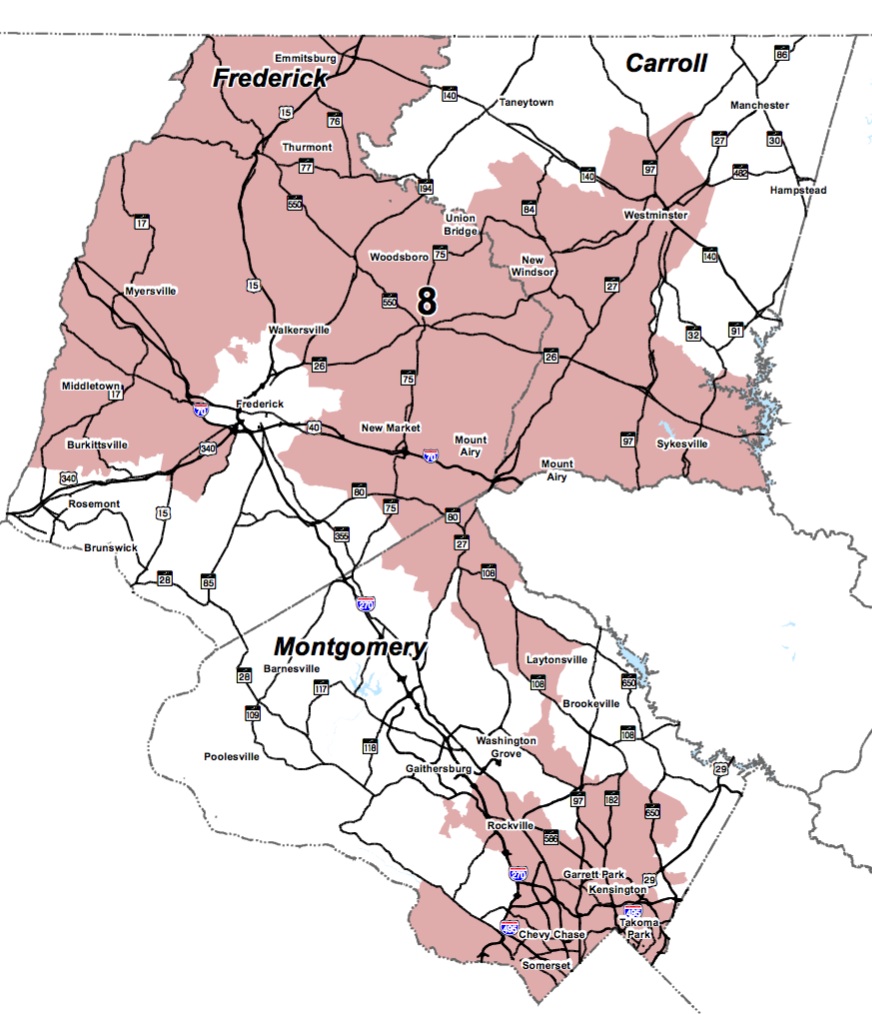 Maryland’s Eighth Congressional District
Maryland’s Eighth Congressional District
Maryland’s eight districts had the lowest average compactness score of any in the nation, according to both the Dispersion and Perimeter measures.
All four of the above districts are contiguous but very thinly at some points. The 8th has a small link south of Laytonsville to connect the very Democratic southern Montgomery with heavily Republican areas in Frederick and Carroll in a manner that benefits Democrats.
In order to let Rep. Steny Hoyer in the 5th keep areas he desired in northwest Prince George’s around College Park, the 4th skirts narrowly around the edges of Prince George’s and Anne Arundel. This corridor connects heavily black and Democratic areas in Prince George’s to very Republican parts of Anne Arundel. The overall district is a black-majority Democratic seat.
Some have claimed that the 3rd in the least compact district in the country. It certainly gives others a run for their money, as it snakes around the State to take in parts of four counties and Baltimore City. Narrow corridors connect three discrete sections of Baltimore City and County.
The district then meanders west to take in a contiguous chunk of south Howard and northeast Montgomery before arcing through Anne Arundel. It has to jump across water to maintain contiguity with Annapolis and at other points. Apparently, Rep. Sarbanes wanted to keep representing that city.
I think the 2nd may be my personal favorite. Narrow corridors allow it to take in separate portions of Baltimore County before crawling up the coast to take in the most Democratic portions of Howard. It then wanders into Baltimore City and cuts across the harbor on its way to Anne Arundel.
It’s easy to ascribe the non-compact shapes to partisanship. However, the shapes stem even more from the desire to satisfy certain Democratic incumbents–primarily Cummings, Hoyer, Ruppersberger, and Sarbanes–from the look of the map.
Several of these incumbents live close to each other in the Baltimore area even as population and political power has shifted away to other portions of the State. Baltimore City is now too small for even one congressional district. Yet it still has three.
In the next post, I examine why, just like among people, pretty isn’t always fair in redistricting.

